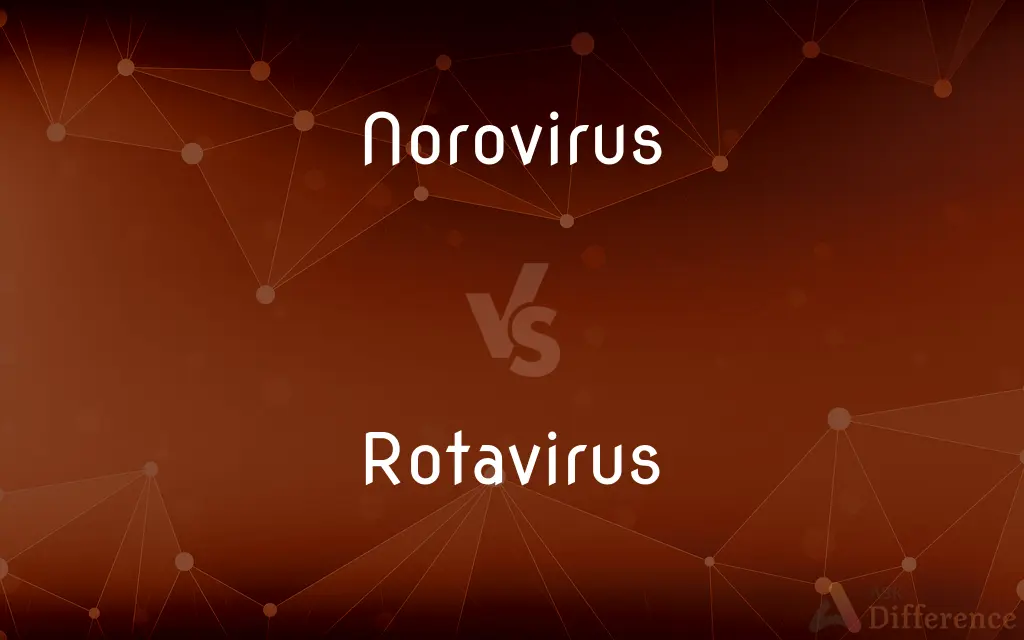Norovirus vs. Rotavirus — What's the Difference?
Edited by Tayyaba Rehman — By Fiza Rafique — Updated on September 20, 2023
Norovirus and rotavirus are both contagious viruses causing gastroenteritis, but norovirus affects people of all ages, while rotavirus primarily impacts infants and young children.

Difference Between Norovirus and Rotavirus
Table of Contents
ADVERTISEMENT
Key Differences
Norovirus and rotavirus are two distinct viruses, both known for causing gastroenteritis, an inflammation of the stomach and intestines. While they share this commonality, the demographics they impact, and their modes of transmission can differ. Norovirus, for instance, affects individuals across all age groups.
Rotavirus, in contrast to norovirus, predominantly affects infants and young children. Due to its severe impact on this younger demographic, vaccinations against rotavirus have become standard in many countries. These vaccinations have led to a noticeable decline in rotavirus-related illnesses in regions where they are administered.
Both norovirus and rotavirus are highly contagious and can spread rapidly in closed environments like hospitals, daycares, or cruise ships. Norovirus can often be transmitted through contaminated food or water, direct contact with an infected person, or touching contaminated surfaces. Rotavirus, meanwhile, is primarily spread through the fecal-oral route, often due to inadequate hand-washing after changing diapers or using the toilet.
Symptoms of infections caused by both norovirus and rotavirus can be similar, including diarrhea, vomiting, and stomach pain. However, norovirus symptoms typically last for 1 to 3 days, whereas rotavirus symptoms can persist for up to a week, especially in young children.
Preventive measures against both viruses include maintaining good hand hygiene. For rotavirus, vaccination offers significant protection. Unfortunately, there isn’t a specific vaccine against norovirus, making hygiene practices all the more crucial.
ADVERTISEMENT
Comparison Chart
Affected Demographic
People of all ages
Primarily infants and young children
Transmission
Contaminated food/water, direct contact, contaminated surfaces
Fecal-oral route, especially in daycare or healthcare settings
Vaccination
No specific vaccine available
Vaccines available and commonly given to infants
Duration of Symptoms
1 to 3 days
Up to a week
Common Environments
Hospitals, cruise ships, closed environments
Daycares, hospitals
Compare with Definitions
Norovirus
A contagious virus causing gastroenteritis in people of all ages.
The cruise ship had an outbreak of norovirus, affecting many passengers.
Rotavirus
A virus primarily affecting infants and young children causing gastroenteritis.
The daycare had several cases of rotavirus last month.
Norovirus
Transmitted through contaminated food, water, or surfaces.
The salad was suspected to be the source of the norovirus outbreak.
Rotavirus
Vaccines are available and commonly given to infants.
Getting the rotavirus vaccine can prevent severe illness in babies.
Norovirus
No specific vaccine available for prevention.
Handwashing is vital in the absence of a norovirus vaccine.
Rotavirus
Known for its fecal-oral transmission route.
Rotavirus often spreads in settings where hand hygiene after diaper changes is inadequate.
Norovirus
Known for rapid spread in closed environments.
The hospital isolated patients showing norovirus symptoms to prevent further spread.
Rotavirus
Symptoms can last up to a week, including severe diarrhea.
The toddler was sick for five days, indicative of a rotavirus infection.
Norovirus
Symptoms include diarrhea, vomiting, and stomach pain.
After consuming the tainted oysters, she showed classic norovirus symptoms.
Rotavirus
Most children will have an episode of rotavirus by age 5.
By kindergarten, most kids have built immunity against rotavirus.
Norovirus
Norovirus, sometimes referred to as the winter vomiting bug, is the most common cause of gastroenteritis. Infection is characterized by non-bloody diarrhea, vomiting, and stomach pain.
Rotavirus
Rotavirus is a genus of double-stranded RNA viruses in the family Reoviridae. Rotaviruses are the most common cause of diarrhoeal disease among infants and young children.
Norovirus
Any of a genus of caliciviruses, formerly called Norwalk viruses, that cause acute gastroenteritis.
Rotavirus
Any of a genus of wheel-shaped reoviruses, including one that causes gastroenteritis, especially in infants and newborn animals.
Norovirus
(virology) Norovirus, the genus of Norwalk virus, which causes gastric distress in humans.
The norovirus causes nausea, vomiting, diarrhea and stomach cramping.
Rotavirus
Any of a group of wheel-shaped viruses, of the genus Rotavirus, that causes gastroenteritis and diarrhea in children and animals.
Rotavirus
The reovirus causing infant enteritis
Common Curiosities
Which virus primarily spreads through the fecal-oral route?
Rotavirus primarily spreads through the fecal-oral route.
Which virus affects all age groups?
Norovirus affects people of all ages.
How long do norovirus symptoms typically last?
Norovirus symptoms usually last for 1 to 3 days.
Is there a vaccine for rotavirus?
Yes, vaccines against rotavirus are commonly given to infants.
Can adults get infected with rotavirus?
Yes, but rotavirus predominantly affects infants and young children.
How can you prevent norovirus infection?
Maintaining good hand hygiene and proper food handling can prevent norovirus infection.
What's a common symptom of both norovirus and rotavirus?
Both can cause diarrhea, vomiting, and stomach pain.
Are there treatments for norovirus and rotavirus infections?
There's no specific treatment for either virus, but staying hydrated and rest are crucial.
Is there a vaccine for norovirus?
No, there isn't a specific vaccine available for norovirus.
Which virus is associated with outbreaks on cruise ships?
Norovirus is commonly linked to outbreaks on cruise ships.
Which virus has a significant impact on daycares?
Rotavirus often affects daycares due to its mode of transmission.
When are children usually vaccinated for rotavirus?
Children are typically vaccinated against rotavirus as infants.
Can you get norovirus from contaminated water?
Yes, norovirus can be transmitted through contaminated water.
How long do rotavirus symptoms last?
Rotavirus symptoms can last up to a week, especially in young children.
Are both norovirus and rotavirus contagious?
Yes, both viruses are highly contagious.
Share Your Discovery

Previous Comparison
Paperback vs. Pocketbook
Next Comparison
Fibrewood vs. PlywoodAuthor Spotlight
Written by
Fiza RafiqueFiza Rafique is a skilled content writer at AskDifference.com, where she meticulously refines and enhances written pieces. Drawing from her vast editorial expertise, Fiza ensures clarity, accuracy, and precision in every article. Passionate about language, she continually seeks to elevate the quality of content for readers worldwide.
Edited by
Tayyaba RehmanTayyaba Rehman is a distinguished writer, currently serving as a primary contributor to askdifference.com. As a researcher in semantics and etymology, Tayyaba's passion for the complexity of languages and their distinctions has found a perfect home on the platform. Tayyaba delves into the intricacies of language, distinguishing between commonly confused words and phrases, thereby providing clarity for readers worldwide.
















































